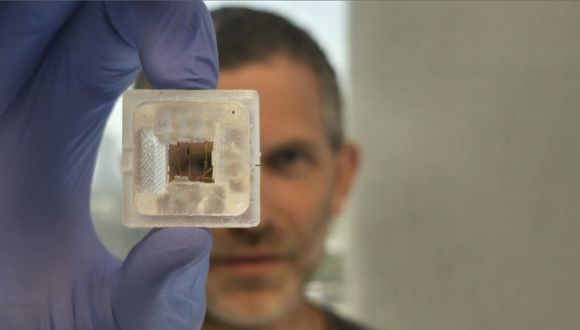
Researchers at Tel Aviv University relied on principles of origami, the Japanese art of paper folding, to develop an original and innovative solution for a problem troubling researchers worldwide: positioning sensors inside 3D-bioprinted tissue models. Instead of bioprinting tissue over the sensors (found to be impracticable) they design and produce an origami-inspired structure that folds around the fabricated tissue, allowing the insertion of sensors into precisely pre-defined locations.
The study was a joint effort of researchers from several units at TAU: the School of Neurobiology, Biochemistry and Biophysics, the Koum Center for Nanoscience and Nanotechnology, the Department of Biomedical Engineering, the Sagol Center for Regenerative Medicine, the Sagol School of Neuroscience and the Drimmer-Fischler Family Stem Cell Core Laboratory for Regenerative Medicine. The researchers are Noam Rahav, Adi Soffer, Prof. Ben Maoz, Prof. Uri Ashery, Denise Marrero, Emma Glickman, Megane Beldjilali-Labro, Yakey Yaffe, Keshet Tadmor, and Yael Leichtmann-Bardoogo. The paper was published in the leading scientific journal Advanced Science.

The 3D Origami Platform integrated in a 3D printed structure.
Prof. Maoz explains: "The use of 3D-bioprinters to print biological tissue models for research is already widespread. In existing technologies, the printer head moves back and forth, printing layer upon layer of the required tissue. This method, however, has a significant drawback: The tissue cannot be bioprinted over a set of sensors needed to provide information about its inner cells, because in the process of printing the printer head breaks the sensors. We propose a new approach to the complex problem: origami".
MSOP: Where Art Meets Science in Bioprinting
The innovation is based on an original synergy between science with art. Using CAD (Computer Aided Design) software the researchers design a multi-sensing structure customized for a specific tissue model - inspired by origami paper folding. This structure incorporates various sensors for monitoring the electrical activity or resistance of cells in precisely chosen locations within the tissue. The computer model is used to manufacture a physical structure which is then folded around the bioprinted tissue - so that each sensor is inserted into its predefined position inside the tissue. The TAU team has named their novel platform MSOP - Multi-Sensor Origami Platform.
The new method's effectiveness was demonstrated on 3D-bioprinted brain tissues, with the inserted sensors recording neuronal electrical activity. The researchers emphasize, however, that the system is both modular and versatile: it can place any number and any type of sensors in any chosen position within any type of 3D-bioprinted tissue model, as well as in tissues grown artificially in the lab such as brain organoids - small spheres of neurons simulating the human brain.
Prof. Maoz adds: "For experiments with bioprinted brain tissue, we demonstrated an additional advantage of our platform: the option for adding a layer that simulates the natural blood-brain barrier (BBB) - a cell layer protecting the brain from undesirable substances carried in the blood, which unfortunately also blocks certain medications intended for brain diseases. The layer we add consists of human BBB cells, enabling us to measure their electrical resistance which indicates their permeability to various medications".
Origami's Scientific Touch
The researchers summarize: "In this study, we created an 'out-of-the-box' synergy between scientific research and art. We developed a novel method inspired by origami paper folding, enabling the insertion of sensors into precisely predefined locations within 3D-bioprinted tissue models, to detect and record cell activity and communication between cells. This new technology is an important step forward for biological research".






